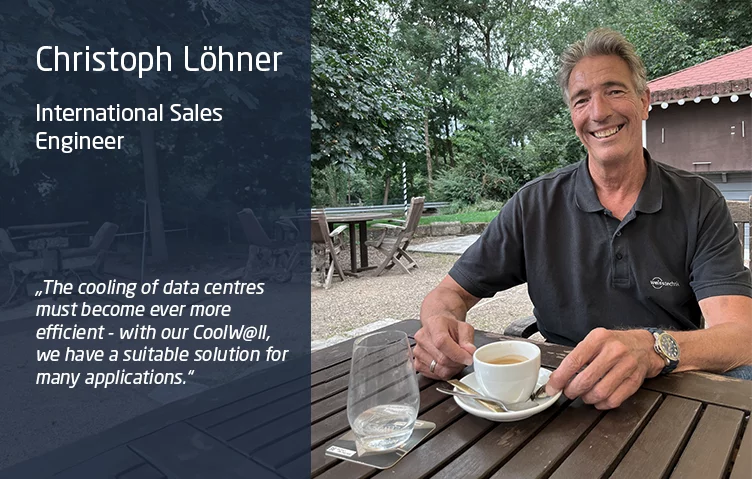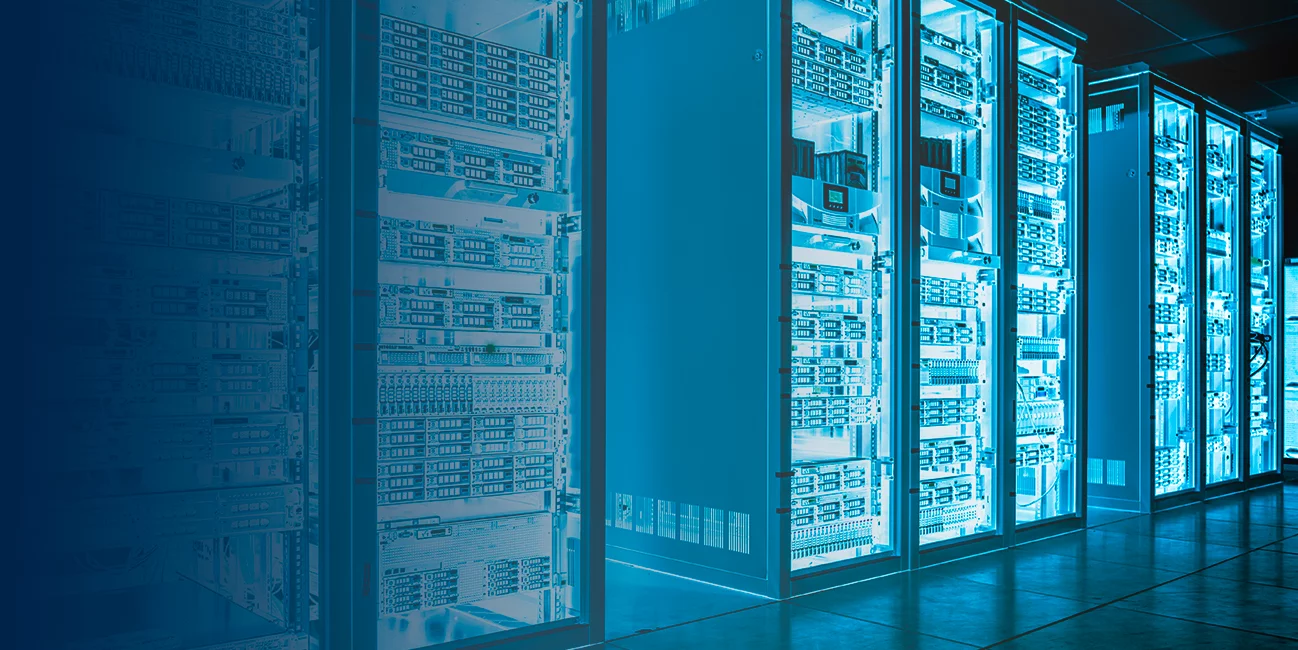The table is set, and the sun is shining. These are perfect conditions for talking about intelligent cooling solutions. Christoph Löhner arrives relaxed wearing a polo shirt, jeans, and trainers. He orders pork shoulder in beer sauce and then drinks a double espresso. In the interview, he provides insights into more than 30 years of cooling technology.
Mr Löhner, what are the latest developments in data centre cooling?
Quite a lot right now. Digitalisation is being accelerated even further by AI, API, OPC, and cloud computing. This requires ever more powerful servers and rack loads of 40 kW and more in high-density data centres. With high energy prices and growing demands on the carbon footprint, the result is a high level of dynamism. That’s why the cooling of data centres is becoming increasingly important.
Why is the focus on cooling in particular?
Data centres require quite a lot of energy. In particular, for the operation of the servers and for their cooling. The power usage effectiveness (PUE) value is calculated to determine the efficiency of a data centre. The PUE value is the ratio between the total energy consumption of a data centre and the electrical energy consumed by IT. The lower the PUE value, the more economically a data centre can be operated.
How is cooling technology for data centres changing?
In two directions. On one hand, existing solutions are being optimised in terms of energy in order to improve their efficiency. On the other hand, new cooling concepts are being developed. The topic of direct liquid cooling of processors is on the rise. Central processing units are cooled directly via a cooling liquid. This is, of course, highly efficient because the cold acts directly on the heat source. However, the cost of server production is increasing, and there are risks in terms of server and data security.
What risks do you mean?
The first is, of course, the physically unfavourable combination of electricity and water. Liquid cooling systems must be extremely fail-safe in order to prevent the servers from being jeopardised. If there is a service issue with the cooling supply, external service technicians may have to enter the data centre to work directly on the processors. This is a real headache for many data centre operators.
Do you think liquid cooling will become established?
Yes. Liquid cooling is already being used successfully and is a good way to efficiently cool data centres. Immersion cooling is an even more efficient development. But it is still in its infancy. Complete servers are immersed in non-conductive cooling liquids. This is a real technology of the future, especially for the high-density sector. However, it also means a complete departure from the familiar, and it is quite expensive to acquire.
How does Weiss Technik position itself in this environment?
We are pioneers in intelligent cooling solutions for data centres and installed cooling systems for the digital switching stations of Telekom across Germany more than 40 years ago. In 2003, we were the first to position the fan separately in the raised floor with our CoolMaster units – a real revolution. With the CoolW@ll family, we present the next stage of development, which is one of a kind on the market. No other room-based cooling system can dissipate such large heat loads. In this respect, I would say that we are at the forefront.
How does the CoolW@ll work, and what advantages does it offer?
The CoolW@ll is a walk-in cooling system that uses the entire width and height of the room for cooling. To this end, we have broken down the air conditioning system into its three main components – fan, heat exchanger, and control cabinet. Placing the fan in the raised floor or in the return air ceiling leaves more space for the heat exchanger and more cooling capacity per area. The filter surface is enlarged and pressure losses are reduced. As a result, this saves up to 25% of energy costs compared with conventional systems.
Does the CoolW@ll have any other advantages?
Yes, an important one that is sometimes wrongly seen as a disadvantage. Splitting the refrigeration solution does initially mean a little extra work during installation. However, transport is much easier, and there are clear advantages in terms of maintenance and service. This is because the CoolW@ll can be serviced from the rear. In the event of a defect, an individual component can be replaced quickly and easily without having to remove the entire unit – a compelling argument for data centre operators.
For which applications are CoolW@ll solutions suitable?
We are currently seeing various use cases. For one, there are data centres that want to increase their server capacities yet maintain the same floor space. There are also data centres that want to increase their energy efficiency and considerably reduce their carbon footprint. We also see a new market for the CoolW@ll in hybrid liquid-air cooling solutions. This is because around 70% of the heat load is dissipated via liquid-cooled processors. The remaining 30% comes from hard drives and transistors. The CoolW@ll offers a simple, efficient, and tried and tested solution. There are also classic colocation and edge computing applications.
Does that sound like a full order book?
Yes, that’s correct. We really have a lot to do at the moment. But we also know that we have to keep developing our solutions in line with market requirements. Compared with the big players, who offer everything from power supplies to racks, we see ourselves as specialists in air conditioning solutions. Our aim is not to serve the entire market but rather to offer the best and most efficient solution in selected areas. And we are doing quite well here. Many customers know and appreciate this.
Mr Löhner, thank you very much for the interview.
“The cooling of data centres must become ever more efficient – with our CoolW@ll, we have a suitable solution for many applications”.
Quick facts
Christoph Löhner, who was born in Frankfurt and now lives in Cologne, is a veteran of Weiss Klimatechnik. The industrial clerk has been working for the company worldwide for 34 years, including in the area of data centre cooling. In his free time, he enjoys exploring the world, reading books about politics and history, and getting inspiration whilst rowing on the Rhine.


